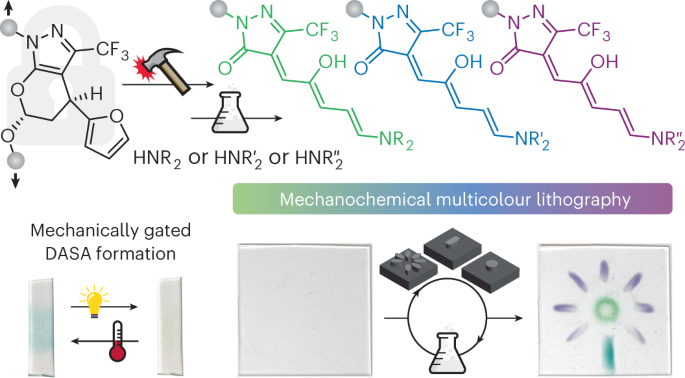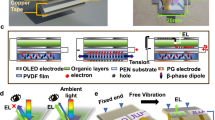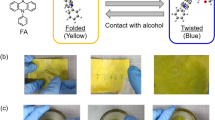Abstract
Stress-sensitive molecules called mechanophores undergo productive chemical transformations in response to mechanical force. A variety of mechanochromic mechanophores, which change colour in response to stress, have been developed, but modulating the properties of the dyes generally requires the independent preparation of discrete derivatives. Here we introduce a mechanophore platform enabling mechanically gated multicolour chromogenic reactivity. The mechanophore is based on an activated furan precursor to donor–acceptor Stenhouse adducts (DASAs) masked as a hetero-Diels–Alder adduct. Mechanochemical activation of the mechanophore unveils the DASA precursor, and subsequent reaction with a secondary amine generates an intensely coloured DASA. Critically, the properties of the DASA are controlled by the amine, and thus a single mechanophore can be differentiated post-activation to produce a wide range of functionally diverse DASAs. We highlight this system by establishing the concept of mechanochemical multicolour soft lithography whereby a complex multicolour composite image is printed into a mechanochemically active elastomer through an iterative process of localized compression followed by reaction with different amines.

This is a preview of subscription content, access via your institution
Access options
Access Nature and 54 other Nature Portfolio journals
Get Nature+, our best-value online-access subscription
$29.99 / 30 days
cancel any time
Subscribe to this journal
Receive 12 print issues and online access
$259.00 per year
only $21.58 per issue
Buy this article
- Purchase on Springer Link
- Instant access to full article PDF
Prices may be subject to local taxes which are calculated during checkout




Similar content being viewed by others
Data availability
All data are available in the manuscript or the Supplementary Information. Experimental data and characterization data for all new compounds prepared in the course of these studies are provided in the Supplementary Information of this paper. The X-ray crystallographic coordinates for compound (±)-3 have been deposited at the Cambridge Crystallographic Data Center (CCDC) with deposition no. 2163133. These data can be obtained free of charge from the CCDC via www.ccdc.cam.ac.uk/structures/. Source data are provided with this paper.
References
Caruso, M. M. et al. Mechanically-induced chemical changes in polymeric materials. Chem. Rev. 109, 5755–5798 (2009).
Beyer, M. K. & Clausen-Schaumann, H. Mechanochemistry: the mechanical activation of covalent bonds. Chem. Rev. 105, 2921–2948 (2005).
Li, J., Nagamani, C. & Moore, J. S. Polymer mechanochemistry: from destructive to productive. Acc. Chem. Res. 48, 2181–2190 (2015).
Berkowski, K. L., Potisek, S. L., Hickenboth, C. R. & Moore, J. S. Ultrasound-induced site-specific cleavage of azo-functionalized poly(ethylene glycol). Macromolecules 38, 8975–8978 (2005).
Kim, G. et al. High-intensity focused ultrasound-induced mechanochemical transduction in synthetic elastomers. Proc. Natl Acad. Sci. USA 116, 10214–10222 (2019).
Davis, D. A. et al. Force-induced activation of covalent bonds in mechanoresponsive polymeric materials. Nature 459, 68–72 (2009).
Gossweiler, G. R. et al. Mechanochemical activation of covalent bonds in polymers with full and repeatable macroscopic shape recovery. ACS Macro Lett. 3, 216–219 (2014).
Kingsbury, C. M. et al. Shear activation of mechanophore-crosslinked polymers. J. Mater. Chem. 21, 8381–8388 (2011).
Versaw, B. A., Zeng, T., Hu, X. & Robb, M. J. Harnessing the power of force: development of mechanophores for molecular release. J. Am. Chem. Soc. 143, 21461–21473 (2021).
Chen, Z. et al. Mechanochemical unzipping of insulating polyladderene to semiconducting polyacetylene. Science 357, 475–479 (2017).
Ramirez, A. L. B. et al. Mechanochemical strengthening of a synthetic polymer in response to typically destructive shear forces. Nat. Chem. 5, 757–761 (2013).
Ghanem, M. A. et al. The role of polymer mechanochemistry in responsive materials and additive manufacturing. Nat. Rev. Mater. 6, 84–98 (2020).
Chen, Y., Mellot, G., van Luijk, D., Creton, C. & Sijbesma, R. P. Mechanochemical tools for polymer materials. Chem. Soc. Rev. 50, 4100–4140 (2021).
Hu, X., McFadden, M. E., Barber, R. W. & Robb, M. J. Mechanochemical regulation of a photochemical reaction. J. Am. Chem. Soc. 140, 14073–14077 (2018).
Barber, R. W. & Robb, M. J. A modular approach to mechanically gated photoswitching with color-tunable molecular force probes. Chem. Sci. 12, 11703–11709 (2021).
Kim, T. A., Robb, M. J., Moore, J. S., White, S. R. & Sottos, N. R. Mechanical reactivity of two different spiropyran mechanophores in polydimethylsiloxane. Macromolecules 51, 9177–9183 (2018).
Lin, Y., Barbee, M. H., Chang, C.-C. & Craig, S. L. Regiochemical effects on mechanophore activation in bulk materials. J. Am. Chem. Soc. 140, 15969–15975 (2018).
Helmy, S. et al. Photoswitching using visible light: a new class of organic photochromic molecules. J. Am. Chem. Soc. 136, 8169–8172 (2014).
Balamurugan, A. & Lee, H. A visible light responsive on–off polymeric photoswitch for the colorimetric detection of nerve agent mimics in solution and in the vapor phase. Macromolecules 49, 2568–2574 (2016).
Diaz, Y. J. et al. A versatile and highly selective colorimetric sensor for the detection of amines. Chem. Eur. J. 23, 3562–3566 (2017).
Chen, Q. et al. Stable activated furan and donor–acceptor Stenhouse adduct polymer conjugates as chemical and thermal sensors. Macromolecules 52, 4370–4375 (2019).
Poelma, S. O. et al. Controlled drug release to cancer cells from modular one-photon visible light-responsive micellar system. Chem. Commun. 52, 10525–10528 (2016).
Lee, J. et al. Tunable photothermal actuation enabled by photoswitching of donor–acceptor Stenhouse adducts. ACS Appl. Mater. Interfaces 12, 54075–54082 (2020).
Helmy, S., Oh, S., Leibfarth, F. A., Hawker, C. J. & Read de Alaniz, J. Design and synthesis of donor–acceptor Stenhouse adducts: a visible light photoswitch derived from furfural. J. Org. Chem. 79, 11316–11329 (2014).
Hemmer, J. R. et al. Controlling dark equilibria and enhancing donor–acceptor Stenhouse adduct photoswitching properties through carbon acid design. J. Am. Chem. Soc. 140, 10425–10429 (2018).
Lerch, M. M., Szymański, W. & Feringa, B. L. The (photo)chemistry of Stenhouse photoswitches: guiding principles and system design. Chem. Soc. Rev. 47, 1910–1937 (2018).
Pałasz, A. & Pałasz, T. Knoevenagel condensation of cyclic ketones with benzoylacetonitrile and N,N′-dimethylbarbituric acid. Application of sterically hindered condensation products in the synthesis of spiro and dispiropyrans by hetero-Diels–Alder reactions. Tetrahedron 67, 1422–1431 (2011).
Stevenson, R. & De Bo, G. Controlling reactivity by geometry in retro-Diels–Alder reactions under tension. J. Am. Chem. Soc. 139, 16768–16771 (2017).
Beyer, M. K. The mechanical strength of a covalent bond calculated by density functional theory. J. Chem. Phys. 112, 7307–7312 (2000).
Klein, I. M., Husic, C. C., Kovács, D. P., Choquette, N. J. & Robb, M. J. Validation of the CoGEF method as a predictive tool for polymer mechanochemistry. J. Am. Chem. Soc. 142, 16364–16381 (2020).
Clerc, M. et al. Promoting the furan ring-opening reaction to access new donor–acceptor Stenhouse adducts with hexafluoroisopropanol. Angew. Chem. Int. Ed. 60, 10219–10227 (2021).
Clerc, M. et al. Donor–acceptor Stenhouse adduct-polydimethylsiloxane-conjugates for enhanced photoswitching in bulk polymers. Macromol. Rapid Commun. 43, 2200120 (2022).
Sroda, M. M., Stricker, F., Peterson, J. A., Bernal, A. & Read de Alaniz, J. Donor–acceptor Stenhouse adducts: exploring the effects of ionic character. Chem. Eur. J. 27, 4183–4190 (2021).
Lui, B. F. et al. Unusual concentration dependence of the photoisomerization reaction in donor–acceptor Stenhouse adducts. Photochem. Photobiol. Sci. 18, 1587–1595 (2019).
Xia, Y. & Whitesides, G. M. Soft lithography. Angew. Chem. Int. Ed. 37, 550–575 (1998).
Mei, Y. et al. Mechanochemical lithography. J. Am. Chem. Soc. 144, 9949–9958 (2022).
Acknowledgements
Financial support from Caltech is gratefully acknowledged. A.C.O. was supported by a National Science Foundation Graduate Research Fellowship (DGE-1745301) and an Institute Fellowship from Caltech. We thank M. Shahgholi for technical assistance with mass spectrometry and M. Takase for assistance with X-ray crystallography.
Author information
Authors and Affiliations
Contributions
M.J.R. conceptualized the project and provided guidance during all stages. A.C.O. and M.J.R. designed the research. A.C.O. and W.G.R. performed the experiments. A.C.O., W.G.R. and M.J.R. analysed the data. A.C.O. and M.J.R. wrote the paper.
Corresponding author
Ethics declarations
Competing interests
A.C.O. and M.J.R. are inventors on a US provisional patent application submitted by California Institute of Technology (CIT 8808-P) covering the chemistry and lithographic process disclosed herein.
Peer review
Peer review information
Nature Chemistry thanks the anonymous reviewers for their contribution to the peer review of this work.
Additional information
Publisher’s note Springer Nature remains neutral with regard to jurisdictional claims in published maps and institutional affiliations.
Supplementary information
Supplementary Information
Supplementary Figs. 1–30, Tables 1 and 2, and Discussion.
Supplementary Data 1
Crystallographic data for compound (±)-3; CCDC reference no. 2163133.
Supplementary Data 2
The XYZ coordinates for the DFT calculations.
Source data
Source Data Fig. 1
Source data for CoGEF plot.
Source Data Fig. 3
Source data for UV–vis spectra.
Rights and permissions
Springer Nature or its licensor (e.g. a society or other partner) holds exclusive rights to this article under a publishing agreement with the author(s) or other rightsholder(s); author self-archiving of the accepted manuscript version of this article is solely governed by the terms of such publishing agreement and applicable law.
About this article
Cite this article
Overholts, A.C., Granados Razo, W. & Robb, M.J. Mechanically gated formation of donor–acceptor Stenhouse adducts enabling mechanochemical multicolour soft lithography. Nat. Chem. 15, 332–338 (2023). https://doi.org/10.1038/s41557-022-01126-5
Received:
Accepted:
Published:
Issue Date:
DOI: https://doi.org/10.1038/s41557-022-01126-5



